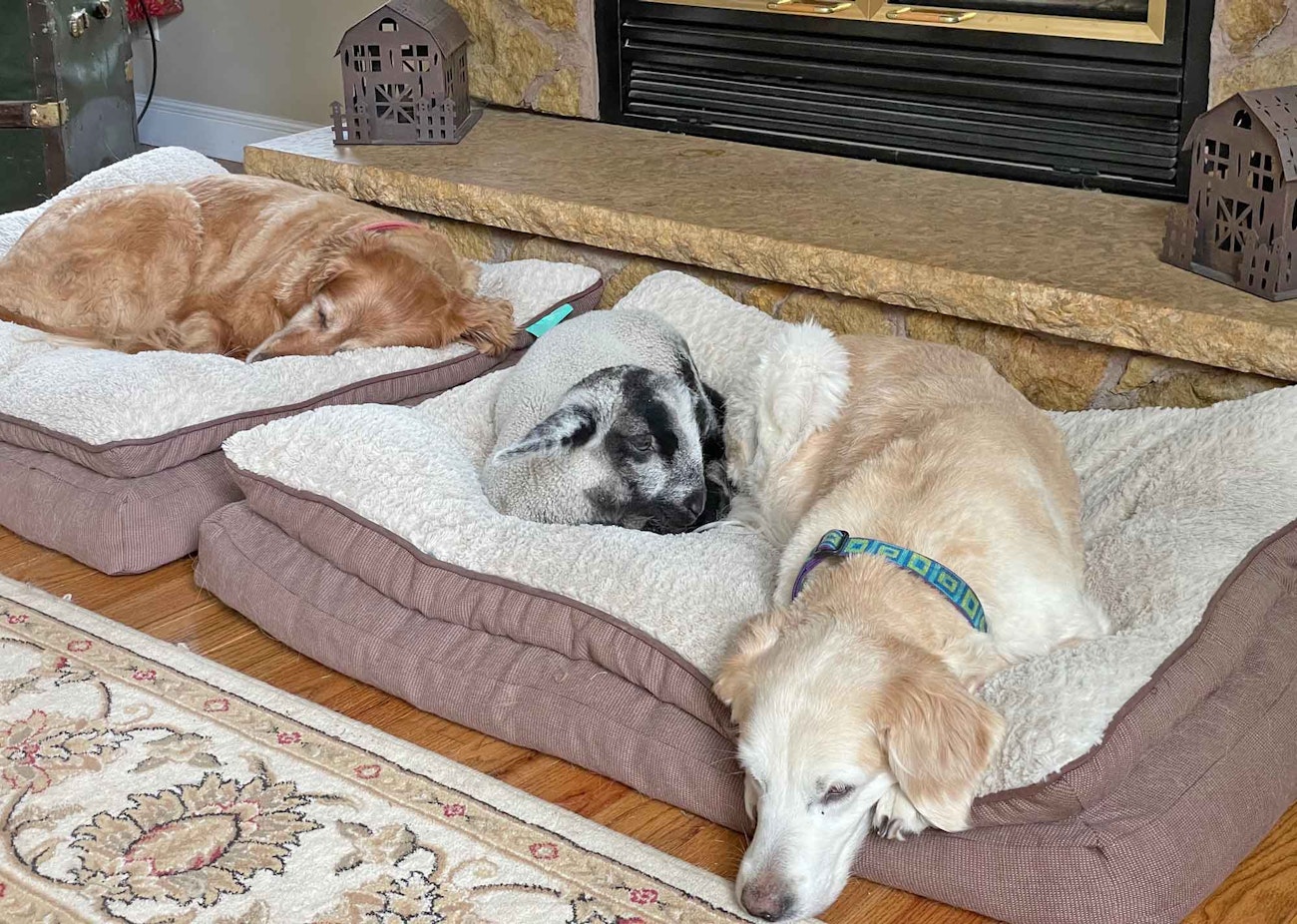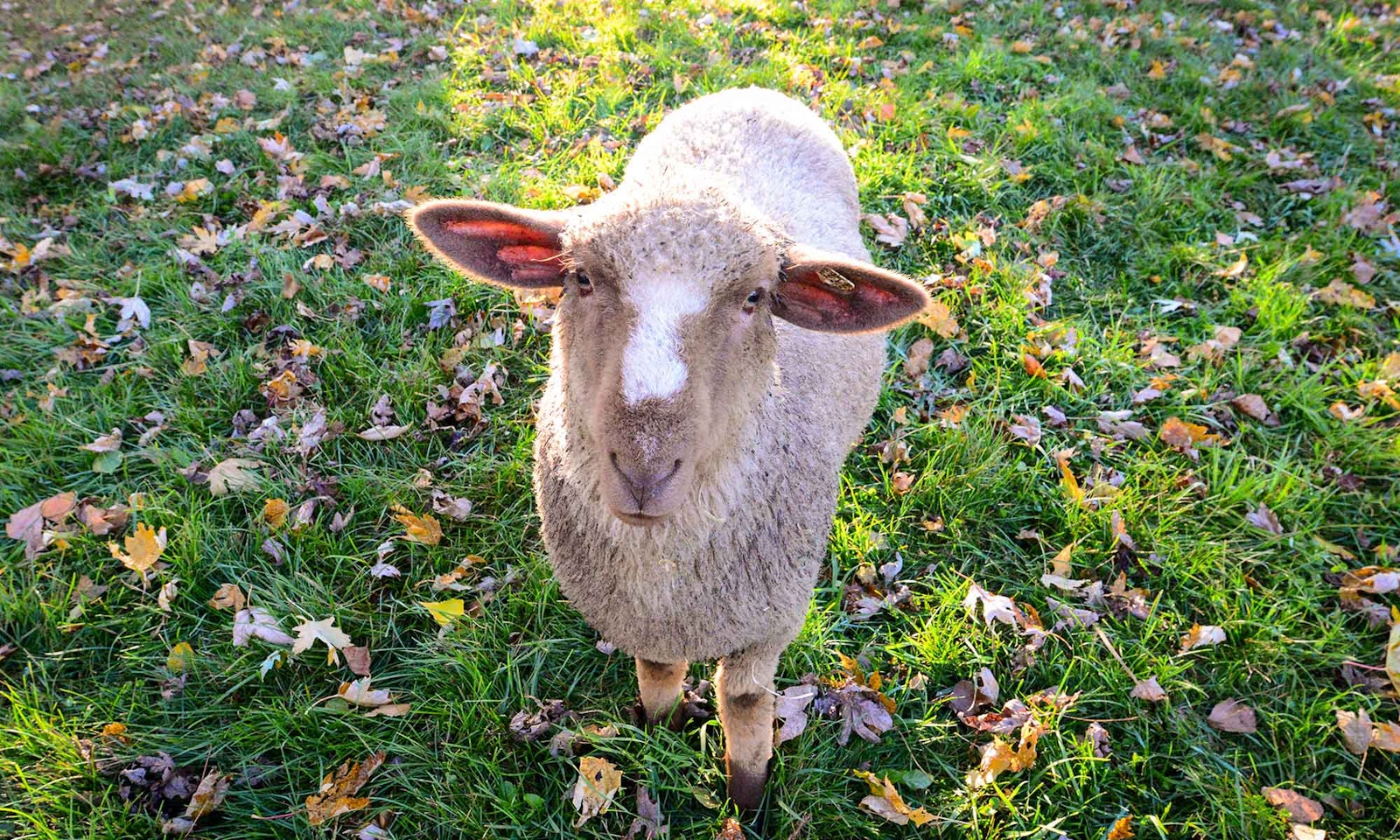Contents
Yarn is the special ingredient that allows knitters the world over to create gorgeous objects—from the practical everyday sweater to the whimsical pair of socks. Yet, if the fiber content of a skein contains wool, there is a kind of magic whose story begins with a sheep. Let’s take a peek at the sheep-to-yarn process at Harvest Hill Acres, a picturesque sheep farm located near Dennison, Minnesota.
Welcome to Harvest Hill Acres
Founded by Diana Weinhardt-Treangen and her husband Dean in 2017, Harvest Hill Acres boasts a spacious fiber studio, about 100 Romeldale/California Variegated Mutant (CVM) sheep, and two guard llamas. All the sheep have names; Piglet, one of the original founding members of the flock, is a tiny ewe with a huge appetite for treats. You can see her below (top left image) in her coat, which helps keep her fleece as clean as possible. Effa, shown above, needed to be bottle fed, but would not take a bottle. According to Diana, “We had to tube feed her 4–6 times a day. Most lambs hate being tube fed, but not Effa! She would sit on my lap and tilt her head back, waiting for me to stick the tube down her throat, and stay perfectly still.”
Get a closer look! Click any image in the gallery below to open it in full-screen mode.
Diana had always wanted sheep and after careful research brought home her first flock in 2015. Due to her wildlife conservation background, she wanted to support conservation by helping preserve a domestic animal in need: Romeldale/CVM sheep. Diana says, “CVMs are amazing fiber sheep! Their wool grows softer with age and it comes in so many natural colors. They are listed by the Livestock Conservancy as a very rare breed that needs more interest.”
Click on any image below to open it in full-screen mode.
Shearing and Fleece Handling
Harvest Hill Acres holds three different shearing events throughout March, April, and May. The sheep are shorn in separate groups by color, starting with the older ewes and ending with the rams. The weather is also a big consideration since wet sheep cannot be safely shorn or their wool properly stored. Diana conducts shearing carefully to ensure that the sheep are humanely handled and their fleeces collected properly.
Within a month of shearing, Diana carefully skirts, weighs, and sorts her fleeces into fiber lots. Diana evaluates each fleece for quality and skirts them vigorously. Skirting, the process of removing the icky bits of wool from the outer edges of a fleece, is key to making awesome yarn. She keeps a spreadsheet of flock wool data to track the wool as it goes through the process of becoming yarn.
Click on any image below to open it in full-screen mode.
Milling and Yarn Design
It takes four to six months for Diana’s wool to be processed into yarn by several different mills. The goal is to get fleeces to the mill in a timely manner to avoid having them languish in storage. Most mills have a minimum weight for processing a fiber lot, so Diana will combine the fleeces to reach the minimum. Diana’s niche yarn brand, Wild Barn Yarn, is special because each batch of wool can be traced back to a single sheep. Her pure wool yarn is best described as soft, springy, and durable, with superb stitch definition. It comes in a wide range of natural colors, from cream, white, beige, and browns, to every shade of gray. A single fleece may only produce 15 to 18 skeins, so she suggests buying a bit more than you think you will need for a project.
Click on any image below to open it in full-screen mode.
One of Diana’s favorite parts of her sheep-to-yarn process happens while making the road trip back from the mill with a fresh batch of newly spun yarn: “Almost every time I get my yarn back from the mill, I can’t wait—I have to pull over and open all the bags to see what it looks like!”
Connection and Appreciation Through Yarn
Diana seeks to build community around the love of sustainable, local yarn. She brings out her newest yarns at monthly “Knit Nights” at the farm, where knitters from all walks of life come out to see where the yarn originates. The most popular yarns are from specific sheep: Noris, Cedric, Kitt, and Fungo—a bottle lamb that was born during the COVID pandemic. “Fungo was our mascot for a while; the first yarns from his fleece were popular because he made everyone smile during those Knit Nights,” Diana says.
 Fungo snuggles with the dogs. Photo by Diana Diana Weinhardt-Treangen
Fungo snuggles with the dogs. Photo by Diana Diana Weinhardt-Treangen
Diana strongly believes in sharing knowledge, and opens up her farm to the University of Minnesota Veterinarian School for visits. Diana takes her yarn to several festivals each year and these trips have inspired her to host her own Harvest Fest this year in September, complete with food trucks, a pumpkin patch, face painting, gift items, and of course, many fiber vendors.
As Diana aptly puts it: “People come to the farm because they want to know where their yarn comes from and our farm is totally here for it. I want to help people find their way, create, and know where their yarn originates.”
Learn more at HarvestHillAcres.com.













